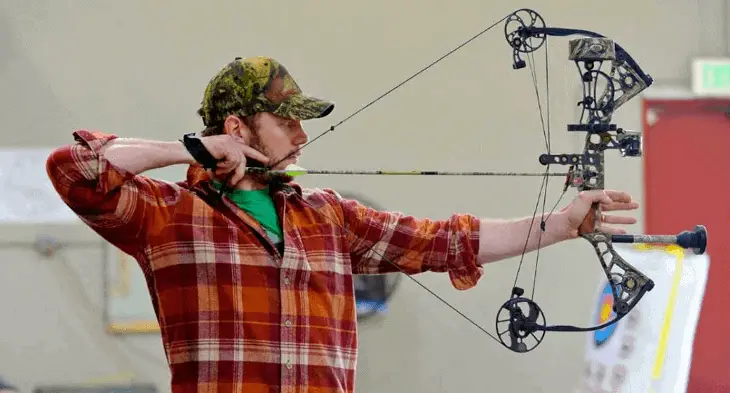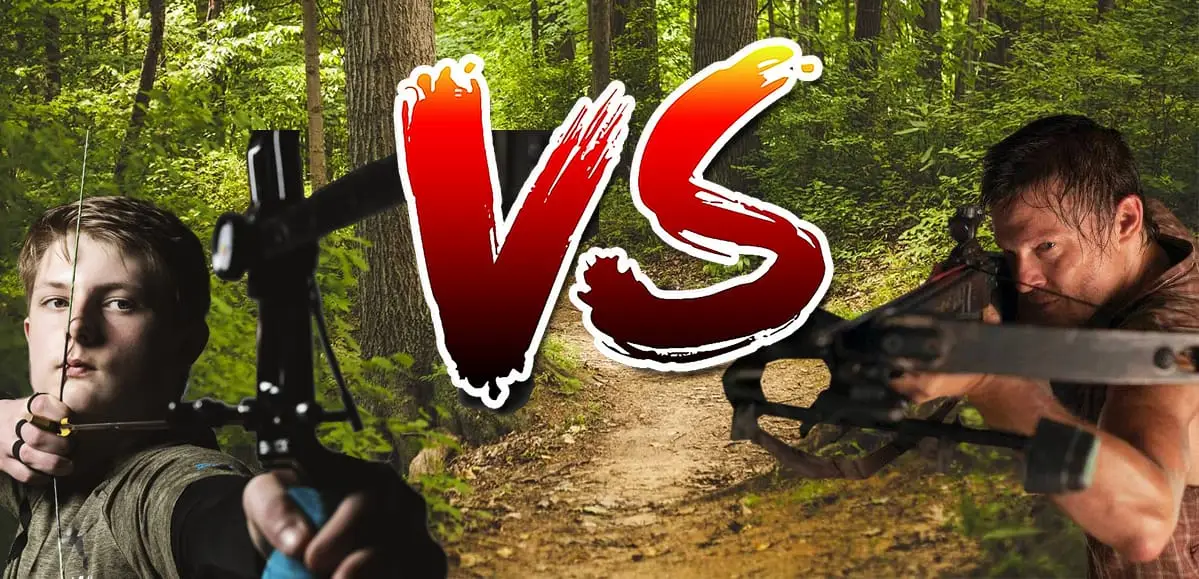Choosing a new bow can be a confusing and overwhelming. More specifically, choosing a new compound bow. There are many different features and decisions to take into account. Take a look below so that you can make an informed decision on your next purchase.
Compound Bow Features
Eye Dominance
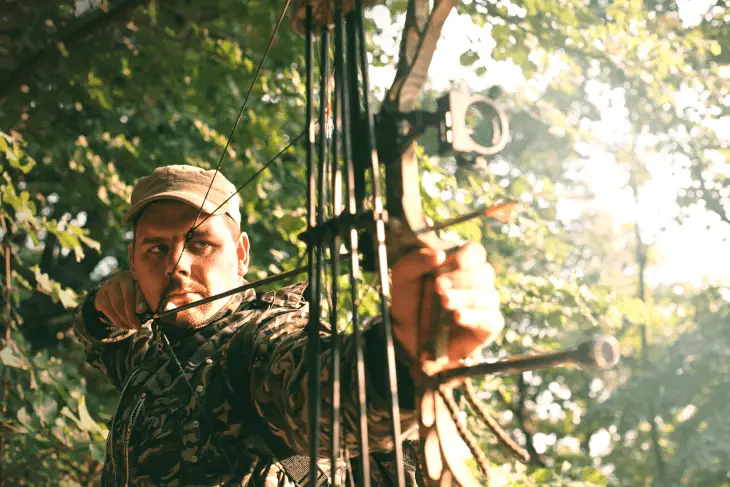
What It Is: Of course, you know you have a dominant hand, and you’ve probably noticed you have a dominant foot. It’s no surprise, then, that you also have a dominant eye. For most people, their dominant eye is the same as their hand. Right handed, right eyed. That’s not always the case, though, so you should check.
Form your hands together into a triangle centered on a distant object. Close one eye and then the other. When you close your dominant eye, the object will shift and be partly covered by your fingers. For example, if your dominant eye is your right, when you close your left, the object will remain unmoved. When you close your right, it will shift.
Why It Matters:
Your dominant eye makes a difference in aiming and can therefore affect whether you want to get a right- or left-handed bow. If you’re like most of the population and your dominant hand and eye are the same, it doesn’t really matter. If they’re different, though, you have a choice to make.
How to Choose:
Aiming a compound bow isn’t an exact science, but you usually look down the shaft of the arrow towards the target. It’s a lot easier, then, if your dominant eye is on the inside. Otherwise, your aim will be off.
An easy solution is just to close your dominant eye. Many archers, especially target shooters, prefer to shoot with one eye closed anyway. If you’re using a right-handed bow but you’re left-eye dominant, close your left eye. Now your right eye will compensate and your aim will calibrate correctly.
Unfortunately, this doesn’t work for everyone. If you just can’t shoot without both eyes open, you might have to get the other hand of bow. Although you usually draw with your dominant hand and hold the bow with your nondominant, most people have no problem switching. This is why it’s important to take your dominant eye into consideration.
Draw Weight
What It Is:
Draw weight refers to how much force is required to pull the bowstring back into position before firing. A draw weight of 50 lbs for example means that it takes the same amount of effort to draw the bow as it would to lift 50 lbs off the ground.
Why It Matters:
Draw weight is one of the simplest of your bows specs but also one of the most important. More draw weight equals more power. More energy gets stored in the bowstring meaning more speed and energy when you fire. As you may guess then, the higher the draw weight, the harder it is to draw the bow and the stronger you’ll need to be.
How to Choose:
It’s not just about muscles. You might want to prove how strong you are and get the highest draw weight out there. While it is true that a big factor in choosing draw weight is your own personal strength, that’s not all. Rather, you’ll use that to determine a range. Here, take a look at this chart.
|
Build of Archer |
Archer’s Weight (lbs) |
Draw Weight Range (lbs) |
|
Small Child |
70-100 |
15-25 |
|
Large Child/Small Woman |
100-130 |
25-35 |
|
Average Woman |
130-160 |
30-40 |
|
Large Woman |
160+ |
45-55 |
|
Small Man |
120-150 |
45-55 |
|
Average Man |
150-180 |
55-65 |
|
Large Man |
180+ |
65-75 |
How to Choose:
Now that you know the range of draw weights to look for based on your size, there are a few other things to consider.
First, what level of experience do you have? If you’re just starting out, you should go with a draw weight on the lower end of your range. In fact, if this is your first time shooting, consider dropping down a weight class on the chart. Heavier draw weights mean more power but they also mean the bow is harder to control. For a beginner, you should work on technique and aim first. Once you have that down, you can increase the draw weight.
Additionally, what are you going to be using the bow for? If you’re a target shooter, you don’t need the heaviest draw weight. You may even want something a little lighter while you’re still honing your skills.
Hunting is a whole other animal. For starters, most states actually have laws requiring bows have a minimum draw weight when used for hunting. This is because draw weight translates to power. To hunt ethically, the bow needs enough power to kill your quarry. Merely injuring causes unnecessary pain to the animal, and you lose your kill. This minimum draw weight tends to be around 40 lbs, so as you can see, a lot of the bows for smaller archers won’t make the cut.
On the other hand, you probably won’t be able to handle as heavy of a draw weight when you’re hunting as you would target shooting on the range. That’s because target shooting is quick draw. You pull back the string, maybe aim for a moment or two, and then fire.
When you’re in a tree stand or still hunting, though, you may end up holding your bow drawn for several minutes while you wait for your quarry to move into the best position. You have to stay absolutely still during this time since movement could make noise. The heavier the draw weight, the faster your arm’s going to get tired holding the bowstring.
As a hunter, you have to find the right middle ground between a draw weight that’s going to be effective against your desired game—not to mention legal—but not so heavy that it ruins your endurance. For whitetail deer, you’ll want a minimum of 40 lbs while larger game like elk, moose and bear require at least 50. Going even higher will increase your chances of success, but be honest with yourself about how much you think you can handle.
Lastly, consider the adjustability of the bow’s draw weight. Many bows have a range of draw weights you can set them too, but the size of these ranges varies significantly. Some may have large ranges from 15-75 lbs while others only offer a small range like 50-65. A large range can be great for beginners because they can work on their technique and slowly increase the weight. Similarly, it’s great for new hunters because they can start low and build up their stamina.
Draw Length
What It Is:
Draw length refers to how far back you can pull the bow string. With compound bows especially, there is a maximum limit that the cams will allow. Longer draw lengths translate to more speed, measured in feet per second. On most compound bows, an inch of draw length translates to 10 FPS of firing speed. If you know your physics, that extra speed and acceleration mean more force and power. After all, the string is going to be pushing the arrow for more time.
Why It Matters:
Knowing this, you might be tempted to get the biggest bow you can find. Unfortunately, the actual length you can draw your bow is limited by your body. Since you hold your bow out with one arm, the longer your arms, the longer draw length you can handle. Maybe you can contort your body to squeeze out a few more inches, but you’re going to ruin your aim and control.
How to Choose:
Common wisdom says you can choose draw length based on your height. However, that’s just an estimate. Ideal draw length comes from arm length or wingspan, not height. For a lot of people, these are the same number. Take it from a lanky guy like me, though, it’s worth it to take a few minutes and measure your wingspan. I’m 6’3” (75 in), which on average would mean a 30-in draw length. My dangling arms, though, have a wingspan of nearly 80 in, which means I should get a bow with a 32-in draw length.
Getting a bow that’s too small for you is going to cause frustration. It’s always going to seem like you’re not getting all the power you could from the bow. You might even subconsciously try to pull the string back too far, and while good compound bows prevent this, repeatedly doing it could wear on the cams. On the other hand, getting a bow that’s too big is going to be hard to handle and aim correctly.
To figure out your ideal draw length, measure your wingspan in inches. That’s the distance from the tip of one middle finger to the other when your arms are stretched out straight parallel to the floor. Take that number and subtract 15, then divide by two. Voila, your ideal draw length.
For example, if my wingspan is 79 inches, I subtract 15 to get 64. Then I divide by two to get 32. If you’re too lazy to do the math, here’s an easy chart.
|
Wingspan (in) |
Draw Length (in) |
|
60 |
24 |
|
62 |
24 |
|
64 |
25 |
|
66 |
26 |
|
68 |
27 |
|
70 |
28 |
|
72 |
29 |
|
74 |
30 |
|
76 |
31 |
|
78 |
32 |
|
80 |
32 |
Axle-to-Axle Length
What It Is:
When shopping for a compound bow, you’ll see a figure called ATA. This refers to the “axle-to-axle” length of the bow. Each limb of a compound bow has a cam, the pulley system that holds the bowstring. These pulleys have axles that attach them to the limbs. The ATA is the distance between these two axles.
Why It Matters:
ATA is a big factor when it comes to compound bows. As a general rule, shorter ATAs, those lower than about 31 inches, mean faster firing speeds. On the other hand, longer ATAs over 34 inches are slower but much easier to control. They’re smoother to draw, and that makes them easier to aim. ATAs in between 31 and 34 inches? Well, you get a little of both advantages but all of neither.
How to Choose:
Short ATAs are popular with hunters simply because they’re smaller. Bigger bows are harder to carry through thick brush and are more likely to make noise. That can make all the difference on the hunt. Long ATAs and their easier control and accuracy are more for target shooting.
If you don’t want to go with an extreme, a midrange ATA is probably fine if you’re not hunting in a particularly dense area and want to increase your accuracy. It can also be a good choice for a beginner. As you get more comfortable shooting and figure out your preferences, you can go with a more specialized ATA.
Let-Off
What It Is:
Compound bows take advantage of simple machines, specifically pulleys, to get more power for less effort. The cam system stores kinetic energy so your arm doesn’t have to. While a recurve or longbow with a 50-lb draw weight requires you to hold a full 50 lbs with your shoulder muscles, a compound bow significantly lessens the load.
The amount a compound bow reduces the draw weight is called the “let-off,” and it’s measured in a percent. For example, if your bow has a draw weight of 50 lbs and a let-off of 80%, the bow’s cam system reduces the actual draw weight down to only 10 lbs. To achieve this, though, you have to draw the string to “the wall.” This is where the cams are fully engaged and the pulley system has decreased the draw weight as much as possible.
If you don’t draw the bowstring all the way back to the wall, you won’t reach full let-off. In fact, just a few millimeters less of draw can significantly decrease the let-off and therefore increase the draw weight. In other words, if you begin to relax your draw and the bowstring, it will suddenly get much more difficult to hold as you move the string closer to the bow.
The rate that the let-off decreases as you move away from the wall is known as “the valley.” A shallow valley means you can relax the string quite a bit before the draw weight gets much heavier. A deep valley means you can relax your draw only slightly and the draw weight will sharply increase.
Why It Matters:
Since let-off decreases draw weight, a high let-off is easier to draw, hold and control. Shallow let-off valleys also mean the bow is very forgiving, while a deep valley means your draw has to be perfect to prevent sudden slips.
How to Choose:
In general, there is not really a disadvantage to let-off. The more the better. However, with incredibly high let-offs, those over 75%, some archers complain about the draw feeling too light. In this case, it can be difficult to really feel the bow and activate the muscles on the draw. When you’re target shooting and even millimeters matter, this can make a difference.
Hunters, on the other hand, should probably just get as high of a let-off as possible. You never know when you’ll have to hold your draw for minutes on end while you wait for your quarry to come into range.
Brace Height
What It Is:
Basically, brace height refers to the distance between the bow and bowstring. It’s measured at the deepest part of the bow’s curve, also known as the throat. This is almost always the same place as the arrow rest.
Why It Matters:
Brace height affects firing speed much in the same way as draw length. Imagine you have a bow with a 30-in draw length. If it also has a 7-in brace height, that means you’re only really drawing the bowstring back 23 inches since the string and therefore the arrow was already seven inches away from the bow at rest.
How to Choose:
If you remember the principles from our draw length section, then you can guess the implication. A shorter brace height means a faster arrow because you can effectively use more of your draw length. Beware, though. Shorter draw lengths, those six inches or less, are very unforgiving of mistakes. They require more precision to be accurate.
That’s why we recommend brace heights over six inches for beginners. That includes those new to compound bows, or those who have shot before but are just getting into a new field like bowhunting for the first time.
Foot Per Second (FPS)
What It Is:
The firing speed of a compound bow is measured in feet per second. When shopping for a bow, you’ll see this number listed along with most important specs. Normally, you’ll see a number between around 250-440 FPS followed by IBO, or occasionally ATA.
IBO stands for International Bowhunting Organization and refers to a standard that the organization uses to measure firing speed. Specifically, to get the FPS measurement of a given bow, they use a version of it with a 70-lb draw weight, 30-in draw length and a 350-grain arrow. The velocity of the arrow as soon as it leaves the bow is its official FPS.
ATA stands for Archery Trade Association, and they use a slightly different standard to determine FPS. It’s used less commonly by bow manufacturers, but just know that if you’re comparing bows, it should be IPO vs IPO or ATA vs ATA.
Why It Matters:
FPS is a pretty important spec to take note of. To go back to physics, a higher velocity means more kinetic energy when the arrow hits your target. That can get your broadheads to penetrate a lot farther, especially into large game. Now, you can still bring down even big game with low FPS. After all, people take down giant Alaskan moose with long bows with under 200 FPS all the time. A higher FPS might be a little more forgiving a little mistake in aim, though, and cut through a tendon or bone it might not otherwise.
Additionally, higher FPS bows are easier to shoot accurately and can hit targets farther away. The faster the arrow, the less it will be affected by outside forces like wind and gravity. It’s going to fly in a straight line for a lot longer after it leaves the bow.
How to Choose:
High FPS has no real downsides in and of itself, but remember that to get higher FPS, you need higher specs in aspects like draw weight and length that can be difficult for beginners to handle. Advice? Don’t just look at FPS and get the fastest bow you can find. Check the other specs as well.
Noise/Sound Quality
What It Is:
Any machine is going to make a bit of extra noise, especially one that launches arrows at upwards of 400 feet per second. Unlike their simple recurve and longbow cousins, compound bows have a lot of moving parts. Specifically, the cams can creak or squeak as they cycle through and the bowstring and risers can vibrate after a shot.
Why It Matters:
Noise is a big deal for hunters. Unwanted noise can spook game and either scare it away or keep it from showing up in the first place. Along with smell, sound is one of the main ways animals like deer detect predators. Their hearing is incredibly fine tuned and something you might not even notice can give you away to a deer that’s still far beyond your field of vision.
How to Choose:
When you’re trying to pick out a compound bow, there are two things to check. The first is the bow itself and the second is the accessories that the manufacturer includes with it.
As for the bow itself, more moving parts mean more noise. What this means is that the more welded joints instead of bolts and nuts the better. Also check to see how noisy the cams are. Cam noise can be decreased by tuning them so they cycle perfectly in sync, but ideally, they should come from the manufacturer already doing that. A new bow with poorly synced cams doesn’t bode well for the bow’s future.
Many accessories also exist to decrease the noise produced by your compound bow. Limb dampeners are little rubber blocks that attach to your bow and absorb the vibration of the limbs, thus reducing sound. Similarly, rubber string dampeners absorb vibration from the string. Finally, string stops still the string after the arrow leaves the bow which keeps it from making noise. When choosing your bow, see which of these accessories come with it.
Cam Type
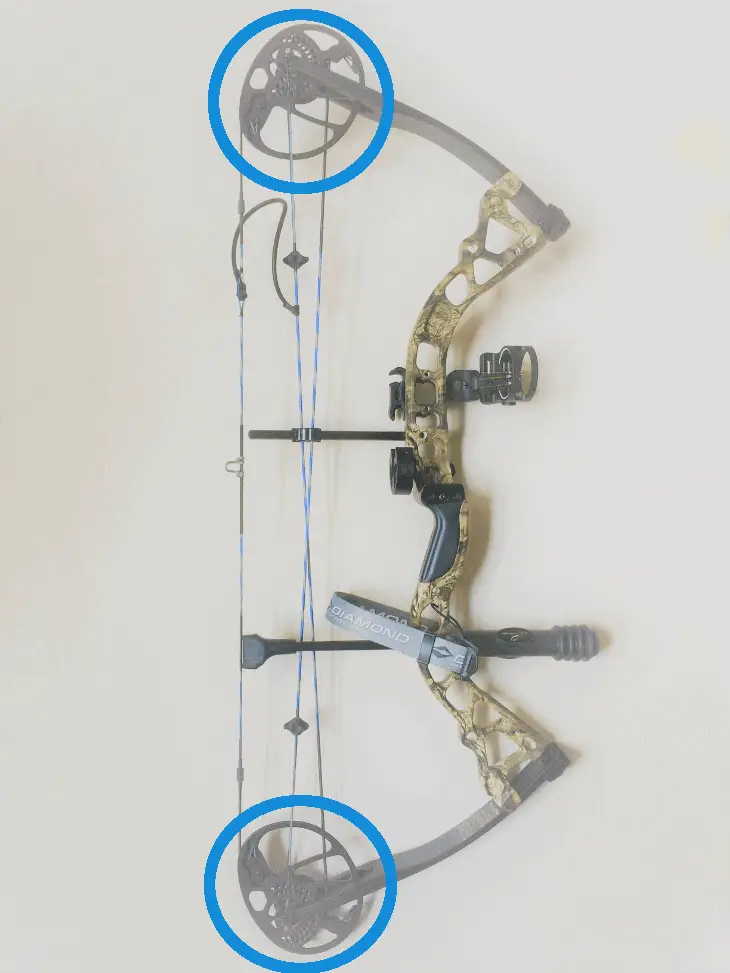
What It Is:
The cams are what make a compound bow a compound bow. The long bows our ancestors used were often taller than a human being. They had to be to have a string long enough to produce sufficient power. Compound bows take a string just as long or even longer but condense the power into a much more compact and easy-to-use weapon via a pulley system.
Why It Matters:
These days, compound bows use cams that are increasingly technologically advanced. There are many types, each with its advantages and disadvantages. Which you choose can make a big difference in your archery experience. It can affect things like firing speed, draw cycle and maintenance.
How to Choose:
The first thing to pay attention to is the type of cam itself, which can be described as either “softer” or “harder” along a spectrum. Soft cams are more circular while hard cams are more elliptical.
Due to the implications of physics and calculus, hard cams take advantage of a higher percentage of the bow’s energy and produce more power and higher firing speeds. Soft cams, however, have much smoother draw cycles and are easier to feel intuitively. That’s why soft cams are almost always the best option for new archers who can then slowly work their way up to harder cams as they gain experience.
Additionally, you have to take note of the type of cam system. There are four different types: single cam, dual cam, twin cam and binary cam.
Single-cam bows are the most basic and probably a good idea if you’re just starting out. They only have one true cam while the other limb merely features an idling wheel. This can have minor effects on accuracy and draw cycle, but it’s a much easier system to maintain. For hunters, it’s also usually a lot quieter.
Twin, hybrid and binary cam systems, which are all considered “dual cam” systems, are all takes on basically the same concept: a cam on both limbs. Each is more technologically advanced than the last, and each uses a different combination of buss and control cables to try to keep the dual cams timed correctly. Buss cables load energy to and from the limbs while control cables keep the cams synced. Here’s a chart:
|
Cam System |
Bow Strings |
Buss Cables |
Control Cables |
|
Single |
1 |
1 |
0 |
|
Twin |
1 |
2 |
0 |
|
Hybrid |
1 |
1 |
1 |
|
Binary |
1 |
0 |
2 |
With two control cables and no dependency on the limbs of the bow at all, binary cam systems have become very popular due to their smoothness, speed and lack of timing issues. They’re new, though, only invented in 2005, so patent issues make them hard to find and expensive when you can.
Overall Bow Weight
What It Is:
Naturally, different compound bows have different weights. At first glance, it might seem like there’s really not that much variation, though. The heaviest you see weigh in at barely six pounds while the lightest are usually around three pounds.
Why It Matters:
However, even this range of three pounds can actually mean a lot, especially for bowhunters. That’s because they’re rarely carrying just a bow. When you’re filling a rucksack with food, gear and safety equipment for a multiple-day hunting trip, every ounce counts.
It’s not just for comfort while you’re hiking through the brush, though. Bowhunters often have to hold a bow in position for several minutes while they wait for their quarry to walk into the ideal position. Anyone who’s worked shoulders in the weight room before can tell you that even just a couple pounds can make a difference even over a long period.
How to Choose:
As a general rule, lighter is better. The only catch is that lighter bows tend to be more expensive. That’s because they’re made from higher-quality materials. For example, carbon fiber has the best combination of durability and light weight, but it also has the highest cost.
Appearance: Colors/Print/Camo
What It Is:
For most of their history, compound bows have only been available in plain colors like black or brown. Lately, though, manufacturers have started finishing their bows in a huge selection of colors, special prints and, of course, camo for hunters.
Why It Matters:
Bow finishes can be a great way to express your personality. For the most part, you can follow your personal preferences. Maybe you like to peacock with neon blue and green, or maybe you’re more of the traditional type and just want an all-black finish.
If you’re a bowhunter, though, you need to be more pragmatic. The obvious answer is a camo print, but even then, there’s a lot to pay attention to.
How to Choose:
First, you need to know a little bit about the game you’re hunting. For example, deer, elk and even other mammalian game like bear, are colorblind. That doesn’t mean they see in black and white. Rather, they can’t distinguish between red and green. To you, that blaze orange or pink really sticks out, but to a buck, it looks identical to all the plants. That’s why you’ll find bows with pink, orange and blue camo prints.
For these types of large game, the pattern is a lot more important than the color when it comes to camo, and the pattern can actually make a big difference. Specifically, vibrant, dynamic patterns can stick out in deciduous forests in the winter when all the leaves have fallen and the landscape is barren and gray. Similarly, snow-white winter camo may be conspicuous in an evergreen forest.
If you’re hunting turkey, though, the color matters a lot more. Turkeys have better vision than deer and can see colors like red, orange and pink. Turkey hunters should probably go with more traditional camo finishes and avoid vibrant colors or experimental patterns.
All this said, vision is not the primary sense for prey animals. How your bow looks is considerably less important than the sounds it makes or the way it smells. Even plain solid colors like black and brown can be effective when you’re hunting.
Bare vs Ready-to-Shoot
What It Is:
We’ve talked a little bit about certain accessories already like string stops and limb dampeners. The full list, though, is much much longer. Compound bows are designed to work with many accessories, all of which serve different purposes.
Two of the most common accessories are sights and quivers. Sights come in many different designs, all of which let you aim accurately at various distances. Quivers let you attach extra arrows to the bow itself for quick access. There are also drop-away arrow rests, bow releases and many more.
Ready-to-shoot bows come out of the box with all the essential accessories and often many extras too. A bare bow is, well, just a bow. You’ll have to get the accessories yourself. It might seem like the choice is obvious, but there are actually a lot of factors to consider.
Why It Matters:
First, accessories are a lot more important for hunters than target shooters. For example, an attached quiver might be convenient for a target shooter, but it can make a huge difference for a hunter who needs to grab a second arrow as fast as possible.
Second, consider the specialization and quality of the accessories. On the one hand, the accessories included by manufacturers are sure to be highly compatible with the bow. This way, you don’t have to check. On the other hand, they’re more likely to be generic.
How to Choose:
All considered, a ready-to-shoot bow can be a good choice for a beginner who still needs to learn how all the accessories work. An experienced archer, however, may have the expertise to pick out the best accessories for their personal situation. Maybe they prefer a caliper bow release and a pin sight, for example. You can’t make those kinds of choices if the manufacturer does it for you.
Lastly, you always want to consider cost. With a bare bow, you know exactly what you’re paying for. When it comes to ready-to-shoot bows, even if the manufacturer says the accessories are “free,” you’re still probably covering at least some of the cost. The bow itself may actually be cheaper than you realize, and to cut down total costs, of a lower quality.
Bow Packages
What It Is:
Bow packages go a step further than ready-to-shoot bows. On top of all the accessories you need, they include extras like arrows and broadheads, a case, an arm guard, and sometimes even a target. Plus, in some cases, a professional will set up, test and tune the bow for you so that you can use it the second you walk out of the store. As an added bonus, the best bow packages actually let you choose your accessories.
Why It Matters:
The primary draw of a bow package is the convenience. Sometimes, however, they can have more practical implications. For example, tuning compound bows to be in sync is essential for accuracy, so professional tuning can be a lifesaver. Plus, you know you’re getting professionally selected arrows and broadheads that will get the job done and a case that will keep your bow safe for seasons to come. Arm guards and targets let you practice at home before you head out into the woods.
How to Choose:
Elaborate bow packages can be ideal for experienced archers and bowhunters who know what they want. Beginners can also benefit since they’ll have a bow they can start using immediately. That said, you should be confident that archery is the hobby for you. You don’t want to pay the money for professional service and top-shelf accessories if it’s going to end up in the back of your closet after one season.
How to Choose a Compound Bow for Hunting
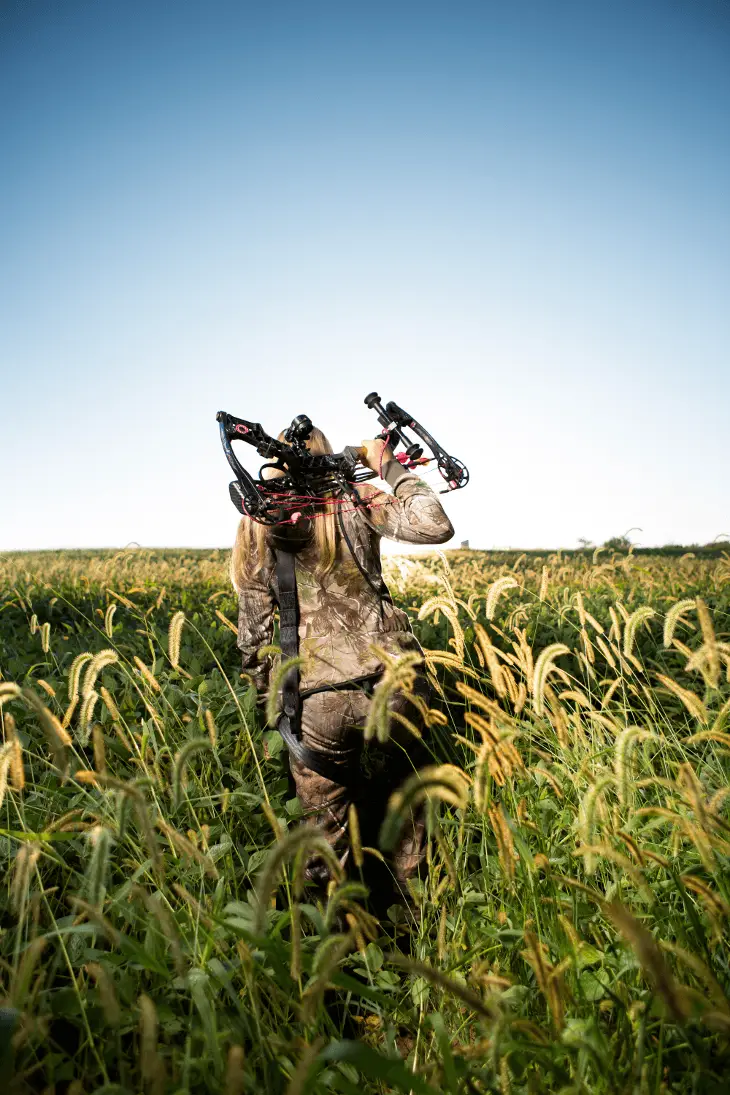
Ask any experienced hunter, and they’ll tell you that every little detail from the body wash you use to the squeakiness of your shoes makes a difference. Your weapon is no exception, so compound bow manufacturers make products with incredibly specialized features for hunters.
First, you need to make sure your bow has the power to take down the game you want. That means checking the draw weight, let-off and FPS. Now, pretty much any compound bow on the market is going to be powerful enough to take down a quarry. Still, you need to look up your local laws to be sure the draw weight meets requirements. Plus, if you’re going to be hunting large game like elk or moose, more power can be the more effective and more ethical choice.
The trade-off for power is always accuracy, however, so you should also be aware of that. Specifically, you should get the right-sized bow with a draw length that won’t be too awkward. Similarly, try to keep the bow weight down and the let-off high so you can hold it steady.
Once you’ve found the right balance between power and accuracy, you can get into the finer details. That means a finish that keeps you hidden in your environment. It also means a quiet bow. To keep noise down, pay attention to your cam system. A single cam is a quiet choice that’s also good for beginners.
Additionally, there are accessories to choose from. Dampeners and string stops are essential for keeping quiet. As a hunter, you also need:
A sight that’s accurate at various distances
A quiver, ideally an attached one
A bowstring release aid
A drop-away arrow rest
Finally, you can’t forget about the price. Like anything in life, you get what you pay for when it comes to compound bows. You don’t have to get the most expensive bow on the market, but cheap bows can be poor quality. That said, an inexpensive ready-to-shoot bow or even full package can be a great way to learn. Just make sure it has the spec to be effective in the field.
How to Choose a Compound Bow for Target Shooting/Recreational Use
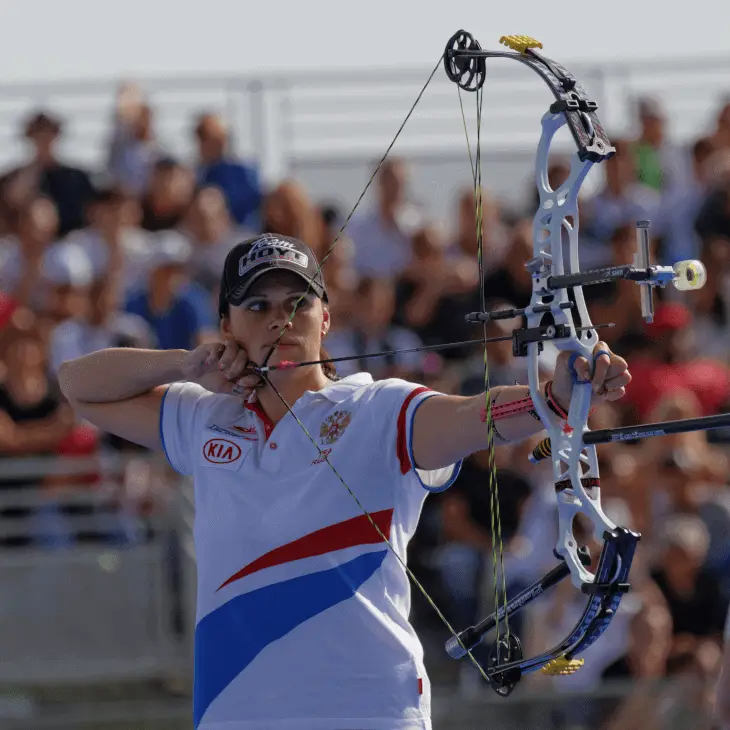
Target shooting is a different animal. Small details like sound and appearance don’t matter as much. Instead, it’s all about accuracy. When you’re looking at a bow’s features and specs, you should have that in mind at all times. Higher draw weights and firing speeds can be great because faster arrows stay straight, but they shouldn’t sacrifice control. Before you start going for more power, make sure you have a bow that’s a size you can control with a smooth draw cycle. Pay close attention to both draw length and ATA.
Similarly, when you’re choosing accessories, you should focus on those that increase control and decrease excess effects on the arrow. Naturally, you need a sight and release. Arrow rests are also important. A good drop-away rest, for example, will let the arrow fly straight out of the bow without anything affecting its trajectory. An accessory called a “bow stabilizer” can also help your control.
Just like hunting bows, a ready-to-shoot bow can be a convenient way to get started. Just don’t pay for a bunch of hunting accessories you’ll never use. Buying a bare bow is also a perfectly fine option. You can then pick out the accessories you like best and make you feel most in control of your bow.

